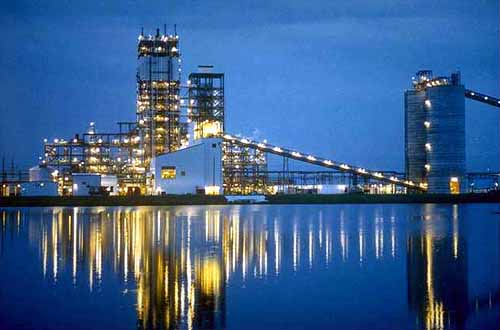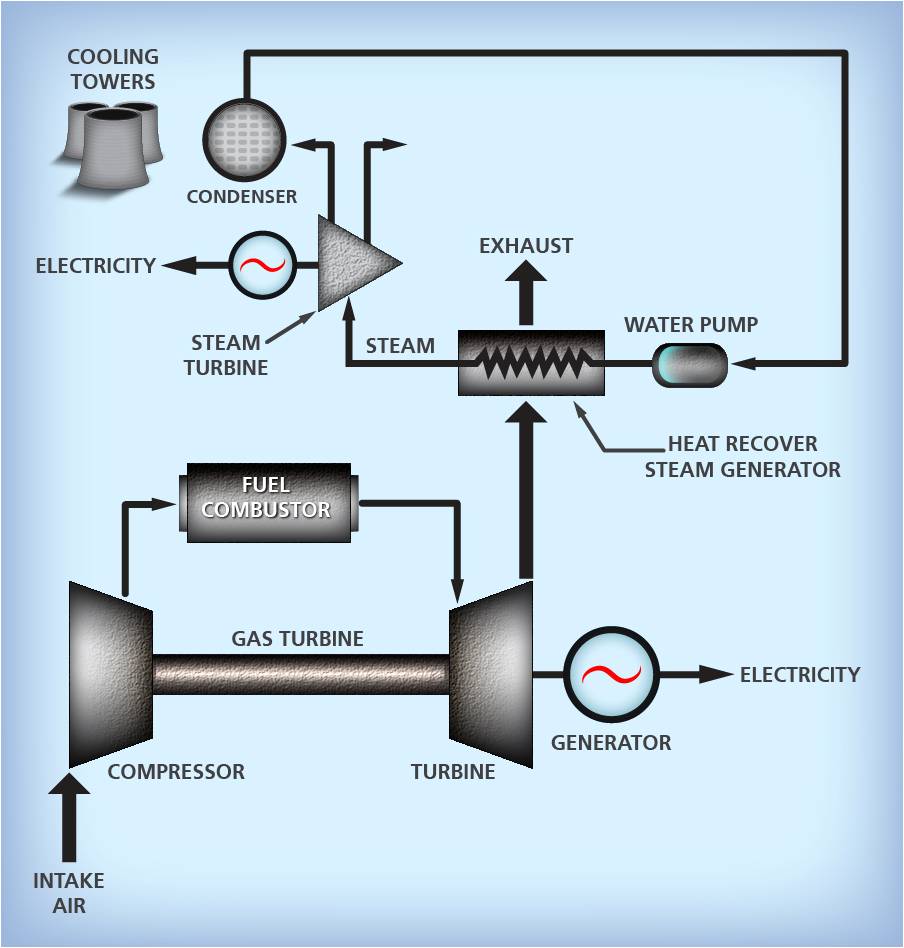
The function of a combined cycle plant is to provide electricity to a local site or, more commonly, a power grid for use by consumers. The major components of a combined cycle plant are a gas turbine, a heat recovery steam generator, a steam turbine, and balance of plant systems.
In order to understand how a combined cycle plant differs from other types of power plants, the functioning principles of other plants should be understood. A simple cycle-type plant consists mainly of just gas turbines, and has no heat recovery capability. The hot exhaust from the turbines is simply released to the atmosphere, which makes the plant much less efficient than other types, but is cheaper to build and operate. In this type of plant, only a gas turbine is used to operate a generator for the production of electricity. Another type of plant is the co-generation plant. It uses the hot exhaust of a gas turbine to produce steam in a heat recovery steam generator. The steam is then sent offsite, where it is used at another facility or to provide steam for processes other than electrical generation. In this type of plant, similar to the simple cycle plant, only a gas turbine is used to operate a generator for the production of electricity.
A plant is only considered a combined cycle plant when the hot exhaust from the gas turbine is used to produce steam in a heat recovery steam generator, which is then used to operate a steam turbine. In this type of plant, the gas turbine and the steam turbine are used to operate generators for the production of electricity.

Major Components
The overall purpose of a combined cycle plant is to provide electricity for consumer use. The gas turbine produces electricity and hot exhaust; the heat recovery steam generator transfers the heat from this hot exhaust to water in order to make superheated steam. The superheated steam produced in the heat recovery steam generator is supplied to the steam turbine through steam piping. The steam is then used by the steam turbine to make electricity, and the exhaust steam is then cooled and condensed back into water in the condenser.
Gas Turbine
The gas turbine uses natural gas or various other fuels, such as No. 2 diesel or kerosene, and compressed air to produce a force to turn the gas turbine rotor that is connected to a generator. The resultant hot exhaust gases from the outlet of the gas turbine are then directed to a heat recovery steam generator to recover the heat before being exhausted to atmosphere.
HRSG
The heat recovery steam generator, or HRSG, which is commonly spoken as “hersig,” removes heat from the hot exhaust of the gas turbine to turn water into superheated steam. This is done by directing the hot exhaust across finned tubes filled with water. This water absorbs the heat and turns into saturated steam. The steam rises up to the drum, and the moisture in the saturated steam is removed by mechanical separators; it is then sent through piping to another set of finned tubes to superheat it. This superheated steam is sent to the steam turbine. The hot exhaust from the gas turbine exits the “hersig” through an exhaust stack to atmosphere.
Steam Turbine
The steam turbine receives superheated steam from the “hersig” in order to turn the steam turbine rotor, which is connected to a generator to make electricity. The superheated steam is directed to the steam turbine from the “hersig” by steam piping. After the superheated steam is used to operate the steam turbine, it is exhausted into the condenser.
Balance of Plant
The balance of plant is comprised of the condenser, condensate, and feed systems. The purpose of the condenser is to receive steam that has been exhausted from the steam turbine and condense it back to water. This is performed by running cooling water through tubes in the condenser, which absorbs heat from the exhausted steam in order to turn it back to water. This water is then pumped from the condenser to either a deaerator or the low-pressure steam drum by the condensate pumps. The feed pumps take suction from the deaerator or low-pressure steam drum to provide water for the high-pressure and intermediate-pressure steam drums.
For more information on combined cycle plants and its individual components, visit the TTS Combined Cycle Wiki page (//www.techtransfer.com/resources/wiki/entry/744/).

